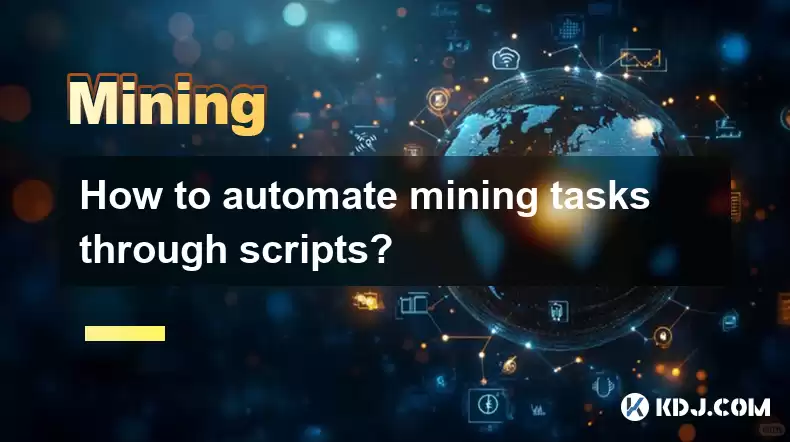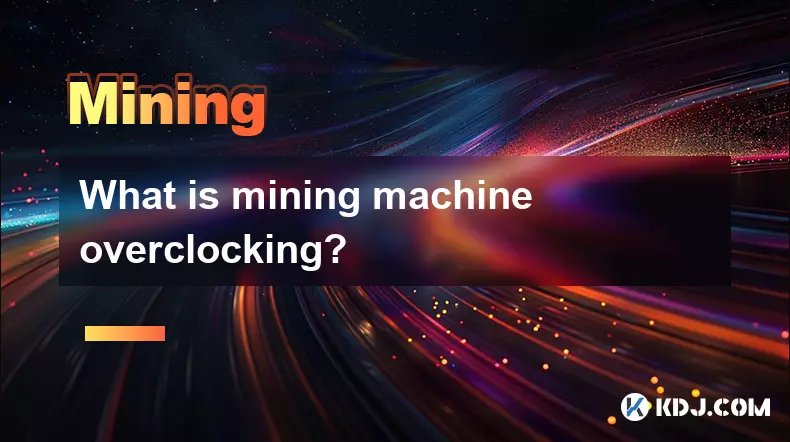-
 bitcoin
bitcoin $114779.865156 USD
2.30% -
 ethereum
ethereum $4226.519789 USD
2.39% -
 tether
tether $1.000545 USD
0.04% -
 xrp
xrp $2.890223 USD
0.92% -
 bnb
bnb $1030.029301 USD
2.95% -
 solana
solana $212.824944 USD
1.69% -
 usd-coin
usd-coin $0.999757 USD
0.01% -
 dogecoin
dogecoin $0.234961 USD
-0.27% -
 tron
tron $0.337174 USD
0.42% -
 cardano
cardano $0.804783 USD
0.09% -
 hyperliquid
hyperliquid $45.748770 USD
-2.85% -
 chainlink
chainlink $21.699170 USD
0.82% -
 ethena-usde
ethena-usde $1.001452 USD
0.08% -
 avalanche
avalanche $30.237800 USD
1.14% -
 stellar
stellar $0.372604 USD
1.52%
How to automate mining tasks through scripts?
Automating mining tasks with scripts can boost efficiency, manage multiple miners, and ensure continuous operation, all while reducing manual labor.
Apr 18, 2025 at 01:29 pm

In the world of cryptocurrency, mining remains a crucial activity for generating new coins and securing blockchain networks. Automating mining tasks through scripts can significantly enhance efficiency and reduce manual labor. This article delves into the intricacies of automating mining tasks, providing a comprehensive guide on how to achieve this using scripts.
Understanding the Basics of Mining Automation
Before diving into the technical aspects of automation, it's important to grasp the concept of mining and why automation is beneficial. Mining is the process by which transactions are verified and added to the public ledger, known as the blockchain. Miners use computational power to solve complex mathematical problems, and in return, they are rewarded with cryptocurrency. Automating mining tasks through scripts can help in managing multiple miners, optimizing performance, and ensuring continuous operation without human intervention.
Choosing the Right Scripting Language
Selecting the appropriate scripting language is crucial for effective mining automation. Python is widely favored due to its simplicity, versatility, and extensive libraries that support various aspects of cryptocurrency mining. Other languages like Bash and PowerShell can also be used, especially for system-level automation on Linux and Windows, respectively. The choice of language depends on the miner's familiarity and the specific requirements of the mining setup.
Setting Up the Mining Environment
Before writing any scripts, it's essential to set up the mining environment properly. This involves installing the necessary mining software, configuring the hardware, and ensuring a stable internet connection. Here's a detailed guide on setting up the environment:
- Install Mining Software: Choose a reliable mining software such as CGMiner, EasyMiner, or MinerGate. Download and install the software according to the manufacturer's instructions.
- Configure Hardware: Ensure that your mining rig's hardware, including GPUs or ASICs, is properly set up and connected. Configure the BIOS settings for optimal performance.
- Stable Internet Connection: A stable internet connection is crucial for mining. Ensure that your network is reliable and has sufficient bandwidth to handle the data transfer required for mining.
Writing the Automation Script
Once the environment is set up, the next step is to write the automation script. Here's a step-by-step guide on how to create a Python script to automate mining tasks:
- Import Necessary Libraries: Start by importing the required libraries. For example, you might need
subprocessfor running system commands andtimefor scheduling tasks.
import subprocessimport time- Define Mining Parameters: Define the parameters for your mining operation, such as the mining software, pool address, and wallet address.
miner_path = 'path/to/your/miner.exe'pool_address = 'stratum+tcp://pool.example.com:3333'wallet_address = 'your_wallet_address'- Create the Mining Command: Construct the command to start the mining software with the specified parameters.
command = f'{miner_path} -o {pool_address} -u {wallet_address}'- Start the Mining Process: Use the
subprocessmodule to start the mining process.
process = subprocess.Popen(command, shell=True)- Monitor and Restart: Implement a loop to monitor the mining process and restart it if it crashes or stops.
while True:
if process.poll() is not None:
print('Mining process has stopped. Restarting...')
process = subprocess.Popen(command, shell=True)
time.sleep(60) # Check every minute
Handling Errors and Logging
Effective error handling and logging are crucial for maintaining the reliability of your mining automation script. Here's how to implement these features:
- Error Handling: Use try-except blocks to catch and handle exceptions that may occur during the mining process.
try:
process = subprocess.Popen(command, shell=True)
except Exception as e:
print(f'An error occurred: {e}')
# Additional error handling logic can be added here
- Logging: Implement logging to keep track of the mining process and any errors that occur.
import logging
logging.basicConfig(filename='mining_log.txt', level=logging.INFO)
while True:
if process.poll() is not None:
logging.info('Mining process has stopped. Restarting...')
process = subprocess.Popen(command, shell=True)
time.sleep(60)
Optimizing Mining Performance
To maximize the efficiency of your mining operation, consider implementing performance optimization techniques within your script. Here are some strategies:
- Dynamic Overclocking: Adjust the clock speeds of your GPUs or ASICs dynamically based on the current mining difficulty and temperature.
import pyopencl as cl
Example of adjusting GPU clock speed
def adjust_clock_speed(gpu, new_clock_speed):
# Implementation depends on the specific GPU and mining software
pass
while True:
# Check current mining difficulty and temperature
if current_difficulty > threshold and temperature max_temperature:
adjust_clock_speed(gpu, lower_clock_speed)
time.sleep(60)
- Load Balancing: If you're managing multiple miners, implement load balancing to distribute the workload evenly across your mining rigs.
import psutil
def get_system_load():
return psutil.cpu_percent()
def distribute_load(miners):
load = get_system_load()
if load > threshold:
# Distribute load to less busy miners
for miner in miners:
if miner.load average_load:
miner.decrease_workload()
while True:
distribute_load(miners)
time.sleep(60)
Frequently Asked Questions
Q: Can I use the same script for different types of cryptocurrencies? A: Yes, you can modify the script to support different cryptocurrencies by changing the mining software, pool address, and wallet address. However, ensure that the mining software you choose supports the specific cryptocurrency you want to mine.
Q: How do I ensure the security of my mining setup when using automation scripts? A: To enhance security, use strong passwords for your mining software and wallet, keep your scripts and mining software updated, and consider running your mining operations on a secure, isolated network. Additionally, regularly monitor your system for any unusual activity.
Q: What are the potential risks of automating mining tasks? A: The primary risks include potential security vulnerabilities if the script is not properly secured, hardware overheating due to continuous operation, and the possibility of the script failing to restart the mining process correctly. Regular monitoring and maintenance can mitigate these risks.
Q: Can I automate the process of switching between different mining pools? A: Yes, you can automate pool switching by monitoring the current performance of different pools and dynamically adjusting the pool address in your script. This requires additional logic to track pool performance and make decisions based on that data.
Disclaimer:info@kdj.com
The information provided is not trading advice. kdj.com does not assume any responsibility for any investments made based on the information provided in this article. Cryptocurrencies are highly volatile and it is highly recommended that you invest with caution after thorough research!
If you believe that the content used on this website infringes your copyright, please contact us immediately (info@kdj.com) and we will delete it promptly.
- Altcoins Primed for 100x Gains: Cryptocurrencies to Watch
- 2025-09-30 22:45:16
- Pi Network, OKX, and Withdrawal Woes: What's Going On?
- 2025-09-30 23:05:12
- Debut Auction & XRP ETF Watch: October 18th Auction Set, Crypto's Big Day?
- 2025-09-30 22:45:16
- Allbridge, Algorand, and Stablecoins: Bridging the Gap in DeFi
- 2025-09-30 23:05:12
- Navigating Solana Wallets: Your Guide to Secure Crypto in 2025
- 2025-09-30 22:50:11
- Shiba Inu's Uptober Rally: Will Exchange Supply Fuel the Fire?
- 2025-09-30 23:10:17
Related knowledge

The difference between staking and mining
Sep 24,2025 at 05:18am
Understanding Staking in the Cryptocurrency Ecosystem1. Staking involves holding funds in a cryptocurrency wallet to support the operations of a block...

How to participate in testnet mining?
Sep 22,2025 at 09:18am
Understanding Testnet Mining in the Crypto Ecosystem1. Testnet mining is a method used by blockchain developers to simulate real-world conditions on a...

How to dispose of abandoned mining machines?
Sep 19,2025 at 08:19pm
Assessing the Condition of Abandoned Mining Rigs1. Begin by inspecting each mining machine for visible damage, corrosion, or missing components. Machi...

How to identify high-quality mining pools?
Sep 21,2025 at 03:19pm
Reputation and Track Record1. A mining pool’s reputation is built over time through consistent performance and transparency. Pools that have operated ...

Advantages of decentralized mining pools
Sep 20,2025 at 04:36pm
Enhanced Security and Resistance to Censorship1. Decentralized mining pools operate on blockchain-based smart contracts, eliminating the need for a ce...

What is mining machine overclocking?
Sep 21,2025 at 07:19pm
Understanding Mining Machine Overclocking1. Mining machine overclocking refers to the process of increasing the operating frequency of a cryptocurrenc...

The difference between staking and mining
Sep 24,2025 at 05:18am
Understanding Staking in the Cryptocurrency Ecosystem1. Staking involves holding funds in a cryptocurrency wallet to support the operations of a block...

How to participate in testnet mining?
Sep 22,2025 at 09:18am
Understanding Testnet Mining in the Crypto Ecosystem1. Testnet mining is a method used by blockchain developers to simulate real-world conditions on a...

How to dispose of abandoned mining machines?
Sep 19,2025 at 08:19pm
Assessing the Condition of Abandoned Mining Rigs1. Begin by inspecting each mining machine for visible damage, corrosion, or missing components. Machi...

How to identify high-quality mining pools?
Sep 21,2025 at 03:19pm
Reputation and Track Record1. A mining pool’s reputation is built over time through consistent performance and transparency. Pools that have operated ...

Advantages of decentralized mining pools
Sep 20,2025 at 04:36pm
Enhanced Security and Resistance to Censorship1. Decentralized mining pools operate on blockchain-based smart contracts, eliminating the need for a ce...

What is mining machine overclocking?
Sep 21,2025 at 07:19pm
Understanding Mining Machine Overclocking1. Mining machine overclocking refers to the process of increasing the operating frequency of a cryptocurrenc...
See all articles










































































